It’s a time-honored tradition.
Recently a friend told me that as a kid, he would go to places in a game that he’d already been to, and found all the secrets in, and travel around anyway. That really took me back.
The neighborhood where I grew up was lush. Trees upon trees loomed over the yards, even the houses. It was a twisting suburb, and you could feel locked into an idyll if you didn’t have a car. And you would want to escape eventually, because for all the evident nature around, there seemed to be nothing to do.

These were cultivated hills, not unchecked paths to riverbeds, or wild dens, or much of anything adventurous. Besides, you didn’t want to go creeping around in peoples’ yards. I wouldn’t have been allowed to roam the quiet streets freely even if I’d asked. And I knew so few of my neighbors—my sibling and I had three local friends, then one.
This beautiful neighborhood, for me, was nothing but a sweet, short diversion before I returned to something entertaining that would give me more of a goal. Often that was TV or a video game.
After my friend and I talked about the joy of exploration in a well-crafted world, we also discussed the joy of movement in a fine platformer. That got me thinking about how playing a video game at that age gave me not just autonomy, but the adventurous freedom of movement that many kids are yearning to have—really, many people of any age and in endless different circumstances.
The freest I felt as a kid might have been when I went to a summer retreat by the sea. I may not have ever been outdoors without a chaperone, but for seemingly the first time, there were creatures and plants of the kind I could go out and discover. The plains and the coast felt endless, but also accessible.

It was vivid and tactile—of course it was, because it was real. But it was pulling on the same wants and needs I felt I could satisfy in my favorite video games. Not deeper needs—the same needs.
Many of my video games were split into levels that had nothing connecting them to each other besides vague visual motifs and were set up as challenges rather than places to explore. Crash Bandicoot appears to be running through a dense tropic with tons of secrets to discover, but really he’s just jumping on enemies and collecting the same standard collectible until he gets to the end. Critically, he’s moving down a well-defined path from point A to point B.
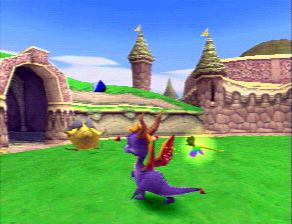
But the game Spyro the Dragon is…well, it’s not that different. Spyro attacks enemies and collects familiar collectibles. He’s being herded from point A to point B by the game designers too. But he also needs to navigate twists and turns, and to experience the joy of dragon-gliding to distant platforms. Puzzles feel different if only because of the way you get to them. (Oh, and I swear I liked more than two games back then. Spyro and Pokemon are just so easy to talk about.)
There’s a greater sense of freedom and exploration there. So when I played Spyro 2 years later in middle school, I was beyond disappointed with how the structure of the game had changed. While the maps were still creative and twisting, the game had shifted away from that free-feeling exploration to give more explicit challenges, and to serve the player tons of new NPCs who tell them what to do. There’s less chance to wander. There’s less to discover on your own.
Ode to the Map
The title screen of Yoshi’s Island shows a rotating model of the game’s setting. As this visual merges with the sounds of waves and rising flutes in the background, it goes from adorable to a little spectacular. When the player is actually selecting a level to play, the map continues purely as an aesthetic. With each level cleared, you move across the dotted line, and your little Yoshi icon travels further along the living tapestry.


Nothing about either map is useful, but it’s such a fun trick to fall for.
My favorite maps in games and fiction are both fun and useful, documents I actually refer back to as I play or read. A guidebook for Pokemon Gold, Silver, and Crystal still sits in my closet. It contains several charming, engrossing maps of the two entire regions those games share, plus smaller maps maps that zero in on specific towns and routes. For me, getting lost in a cave in these games was nigh-inevitable. These smaller maps were useful indeed.
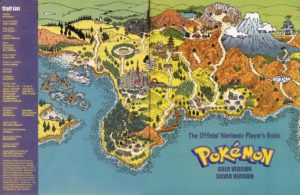
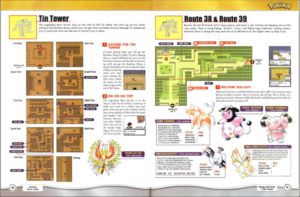
Many, many fantasy novels begin with a map of their worlds. These maps do not meet my Personal Fave Map Standards because I never, ever refer back to them. Unfortunately, and through no fault of their own, they’re so common that they don’t impress me with their grandeur.
But they also never compel me to go back and use them. I guess I feel no reason to, upon reaching the end of Chapter 5, turn back and say, “Okay, so the heroes need to travel fifty more miles to get to the castle.”
Meanwhile, two books I’ve read in other genres that incorporate maps are Ice Station by Matt Reilly and The Mysterious Affair at Styles by Agatha Crispy. Ice Station did a little better, in this regard, by opening with a map of a setting I otherwise found a little confusing. I was so excited to use and almost need the map, but in the end, I never referred to it after the opening chapters. It could not be my dream map.
I have a feeling that the map in Styles is quite a useful resource for solving the crime at the heart of that book (and that later novels by Agatha Crunchy and other detective novelists have no doubt taken maps to higher heights since…unless they’ve abandoned them?). I just wish I had any faith in my own ability to solve detective-novel mysteries. Then again, I’m not sure I’m meant to, given that Detective Poirot is portrayed as a supergenius beyond normal readers anyway.
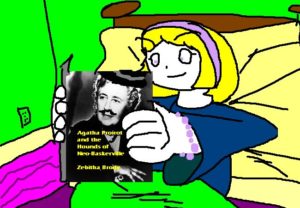
…Wait, why am I so concerned about useful maps all of a sudden? Why would I want to do that or to want to feel any need to do that!? This isn’t a game, it’s a book!!!
Wait…”game”…”book”…..
Gamebooks
Okay, so this one time I got a book from this series called Fabled Lands. It’s not a LitRPG, not a TTRPG, but a gamebook: a book meant to be played, where paragraphs end with branching paths and choices for the reader to make. Besides the Choose Your Own Adventure series, these types of books/games are niche in the United States; if they’re taking off anywhere around the world besides in very small individual game stores in Europe, and in small but devoted circles on the internet, I’d be surprised. (Also, the one time I played a Choose Your Own Adventure book as a kid, I hated it. It was called You’re A Millionaire, but NONE of the decisions were what I would do as a millionaire! A false promise broken in two pages.)
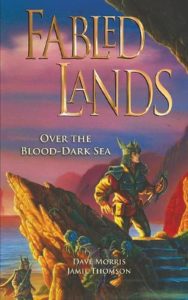
So if you’ve only ever heard of CYOA books, then Fabled Lands will sound like the king of gamebooks. Fabled Lands is a fantasy world split up across seven books, each its own part of a fantasy-world map. But because you’re playing a character in this game, the map has that rare potential to be vitally useful.
Each book in the series drops your character off in a different part of its world. I bought Book 3: Over the Blood-Dark Sea, which is sadly hilarious because I later learned this book is “really hard” and “not the best for beginners.” But what thrilled me about it was the theme. Ships! Pirates! You get to sail around on an endless ocean—and in a book, somehow! It’s Wind Waker!
For me, it was so exciting to refer to the world map not with a spirit of “hmm, it’s yet another fantasy story,” but with the expectation of entering a constructed world. Naturally the choices I could make in each world would be limited—books can’t randomly generate text, and all your options are predetermined—and yet it would feel like an adventure, and the paths and decisions I could take would somehow feel like mine. I could take a ship out to sea and have no way to tell where an entry along the lines of “go north: turn to 374” would take me other than by using that map, that very tactile resource in the front of the book.
…Or I would’ve if the gameplay wasn’t so hard, but you win some you lose some.
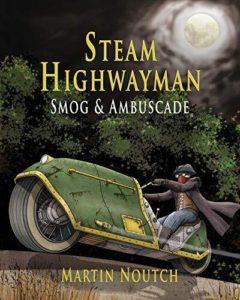
Maybe I’ll buy Book 1 at some point, but on reflection, I think the type of game I’m looking for is Steam Highwayman, a newer gamebook series that takes inspiration from old classics like Fabled Lands to make something entirely its own. You ride through a steampunk Britain across a map dotted with real towns and landmarks.
Imagine if this had been released in the 80s or 90s when gamebooks were almost always marketed to kids and young adults. I can’t imagine those demographics going for it, even though, sure, there is some brawling highwayman action and intrigue. I know I wouldn’t have tried it at that age unless I knew it had monsters or elemental powers of some kind. But now…doesn’t this book sound like one of the coolest things ever? The author took his love of exploring real roads and transformed it into a kind of surreal vacation you can take and inhabit anywhere. It’s a magical concept.
So…Maps and Exploration in LitRPGs?
If you’ve been following my blog lately, you know that I’ve been working on a LitRPG called Catgirl System and publicly tracking my progress so that if I don’t do it fast enough the world (or at least my friends) can point and laugh. It all started with this post titled “Oops! My ‘Quick Side Project’ is Consuming Untold Years” and has spiraled out from there.
And here’s a quick update on that:
You know how when I last gave an update, I was sort of panicking because I hadn’t written at all when company was over? Well, after I recovered from that panic (and you’ll have to read that post to find out how), I started making a greater effort to build writing into my daily routine, and to write in the mornings rather than at random stressful times throughout the day.
I’ve known for a long time that the morning is my favorite time to write. Yes, partly because I can “get it out of the way” and not stress about when I’ll find time later on, in a world where there’s always so much to do. But also because I just like mornings, enjoy getting up early, and associate the time with all the brightness and enthusiasm of a twinkling sun…so…yes.
I’ve also been writing for bigger blocks of time than before…much bigger. For me, “much bigger” means two and a half hours at a time. There are definitely gaps where I stare into space and question myself, my stamina, and what the heck I’m even writing this go-around. But it tends to work out.
So here’s my progress bar:

I might actually finish this draft before the year is over! That’s pretty exciting. Out of an estimated 150 chapters, maybe more maybe less, I’m on chapter 130.
Only then will it be time to smooth out the story-canvas and edit out anything that could possibly be called “unfortunate”…!
Wait, I forgot this section heading said something about maps and LitRPGs, so let’s get back to that.
Are there any LitRPGs where a world map is not only included, but important? I mean, there has to be one. More than one. There are so many LitRPGs out there that I have barely scratched the surface of them, so it’s totally possible that someone is reading this saying, “I can’t believe you didn’t read The Mappal Hunter or He Who Fights with Maps yet!”
Well, long story short, I am intrigued by the idea of having a LitRPG that revolves, either somewhat or entirely, around mapmaking. And in general, I like the idea of LitRPGs that aren’t driven by fighting, or even by crafting or tower defense or running an business. Naturally, maps play some role in Catgirl System, and I’m sure I included mapmaking in the story because I find the idea of world maps comforting and a little thrilling, which definitely fits the tone I’m going for.
If the story I’m making can channel even a bit of my love of adventuring and moving freely in the splotches of nature that suburbs and cities still allow to grow, then I’m happy. I can’t say Catgirl System will become a classic, but I hope that it gets other people out there to at least remember something else they have loved about games.
Thank you for reading, and Patrons, thank you for Patreonning.
…Speaking of things you (may have) loved, I also blog about early Pokemon and how it hurts my brain, weird ignorant things I did as a child that also hurt my brain, and BlazBlue, which makes total sense to me.

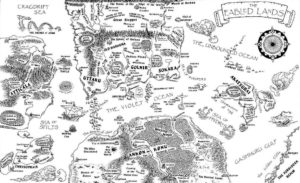
I await your world map